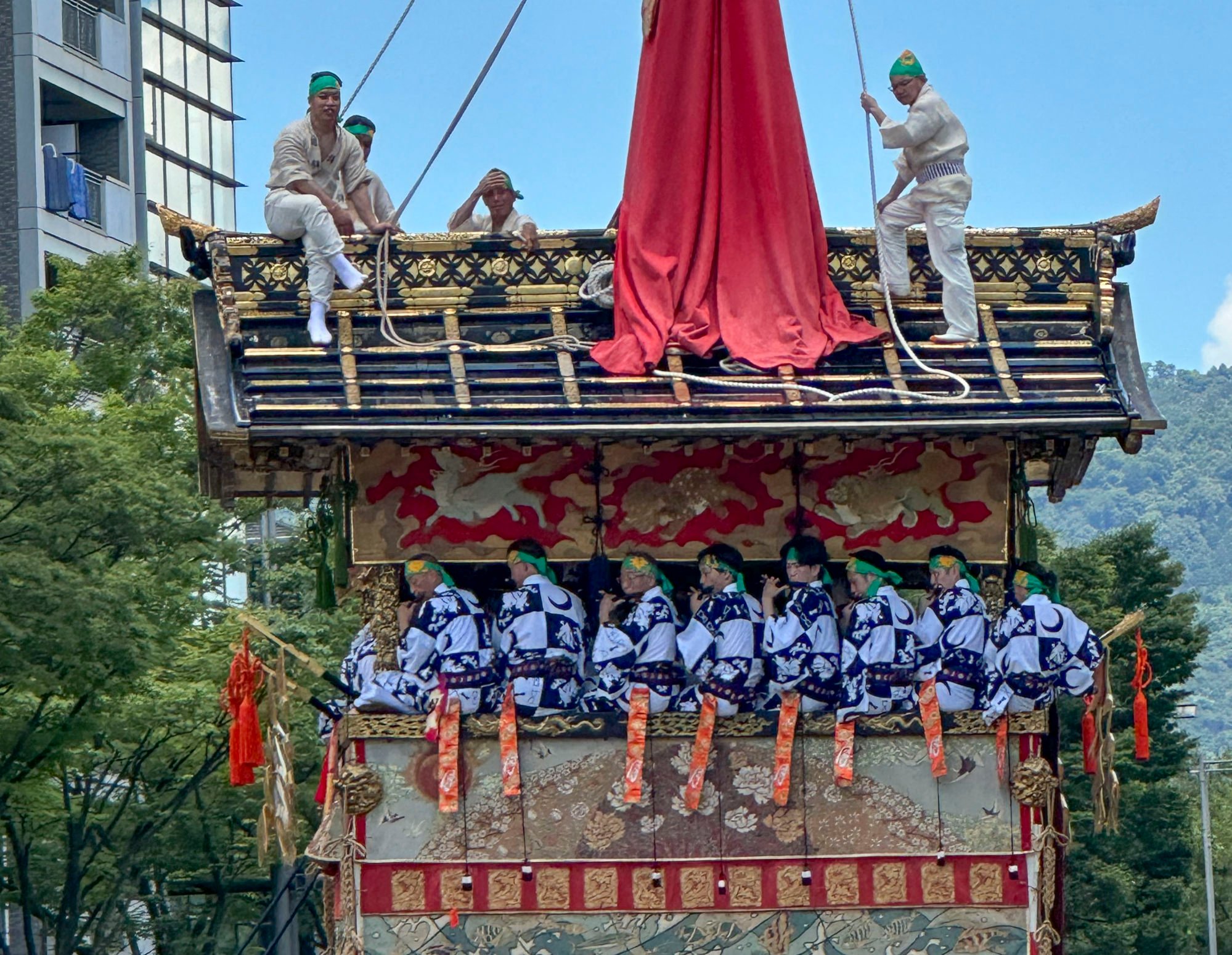Explainer | Why Kyoto’s Gion Matsuri, Japan’s most famous festival, with its parade of huge floats, is not to be missed
A towering float – complete with a wooden pole that easily rises six storeys – heaves into view.
The float is elaborately decorated with tapestries festooned with gold, and has jet-black wheels taller than the average adult. About 50 people surround it, while a few stand guard on the roof and others sit inside.
The focus of spectators gathered at a road junction in Kyoto, Japan, is on the front of the float, where volunteers are pouring water on bamboo slats laid on the ground to help this behemoth slide through a 90-degree turn.
With loud chants and raw power, the volunteers direct the heavy structure through two small turns. Finally, with one big push, they turn the corner and begin moving forward again.

The crowd breaks into applause.
The Gion Matsuri is perhaps the most famous of Japan’s many and varied festivals. It is certainly Kyoto’s most important celebration.

The festival is organised by the Yasaka Shrine and held throughout July across the city, but it is the Gion neighbourhood in particular that springs to life, with most residents taking part in one way or another.
Families offer private art collections for public view, the creatively inclined decorate their district’s float and a chosen few have the honour of joining the Yamaboko Junko (“float procession”), an event recognised by Unesco as intangible cultural heritage.
The Gion Matsuri began as a purification ritual. In 869AD, Kyoto, then the capital of Japan, was ravaged by plague, so the emperor ordered that 66 spears – one for each of the country’s provinces – be erected and deities transported through the streets in portable shrines, called mikoshi, in an effort to appease the gods and prevent further suffering.
The festival has been held for the past 1,150 years, surviving wars, natural disasters and, yes, pandemics. There have been only a few occasions in the past century when it has been absent from Kyoto’s streets: following World War II; in 1962, when the city’s subway was being built; and during the Covid-19 lockdown.
In 2023, the Gion Matsuri was held without any restrictions for the first time since 2020, allowing revellers to freely enjoy the atmosphere as vibrant ohayashi – traditional Japanese music – filled the air.
Establishments in Kyoto mark the festival in their own symbolic way. At Hotel the Mitsui Kyoto, an Andre Fu-designed property near Nijo Castle, the typical white monmaku (gate curtain) is replaced with a more jovial purple one, for example.
Celebrations reach a fever pitch on the three days preceding July 17, the main day of the festival.
From July 14 to 16 – a period referred to as Yoiyama – downtown Kyoto is transformed into a wholesome block party, its streets lined with traditional lanterns, stalls selling taiyaki fish-shaped cakes and okonomiyaki (best enjoyed with a cold draught beer) and festivalgoers dressed in yukata (summer kimonos).

During Yoiyama, the enormous floats are illuminated and parked near the intersection of Karasuma and Shijo streets, their paper craft, metalwork and intricate wooden structures – some made without a single nail – open for inspection.
July 17 is known as Saki Matsuri Junko, when the grand procession unfolds, with 23 yama (shoulder-borne litters) and 10 hoko (large floats, some 25 metres – 80 feet – tall and weighing up to 12 tonnes) weaving their way through the streets.
The procession route is 3km (1.9 miles) long, but it is at the Kawaramachi-dori intersection where most of the action takes place, volunteers cheering, chanting and dancing as the hoko navigate the turn. The yama are spun three times as they are turned.
The anticipation was palpable as the tapestry-draped Naginata Boko float, which bears the sacred chigo – a child selected to be a “divine messenger” – and always leads the procession, started making its way down the street.
The succeeding floats are decided by lottery, and second on the roster was the three-ton Yamabushi Yama float. Meaning “one who bows in the mountains”, Yamabushi Yama are adherents of the ancient spiritual practice of Shugendo.
On the roofs of the tall floats perch people who direct the cumbersome vehicles through the narrow streets and help remove overhead cables from their path.

It is hot up there. Summer temperatures can be extreme in Kyoto, which is situated in a valley and is akin to a rice bowl, the Japanese say, the stifling heat settling at the bottom.
Perhaps it is no surprise that the Gion Matsuri is also known as the Hamo Festival, a time when, throughout Kyoto, you can find eel dishes that are energy rich and, so it is claimed, help participants conquer the humidity. The hamo is an eel-like fish.
During 2023’s Saki Matsuri Junko, the temperature reached 38 degrees Celsius (100 Fahrenheit). The Japanese meteorological agency issued a heat warning and ordered ambulances to be at the ready.
Nevertheless, the heat did little to deter crowds from gathering early, to stake out positions on the streets ahead of the two-hour parade, which began at 9.30am.
Nor did it seem to sap the energy of volunteers of all ages who pulled the floats through the streets of Kyoto, their brows dripping with sweat and their faces beaming with pride.
In 2023, for the first time, the organisers erected a seating area at the southwest corner of Kawaramachi Oike street, promising views of Kawaramachi-dori and a different perspective on the festival. (Places can be reserved through the festival’s website or through the concierge desks of the city’s hotels.)
Upon arriving at the minimalist but shaded seating area, I was led to a tatami chair and given a “survival pack” including a traditional fan (uchiwa) and a cold bottle of the Japanese sports drink Pocari Sweat.
The most helpful item, however, was a translation device (to be returned) that provided a deeper understanding of the visual spectacle.

